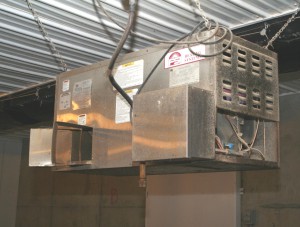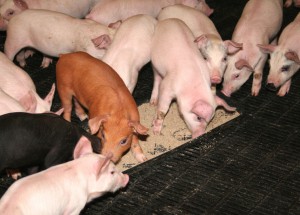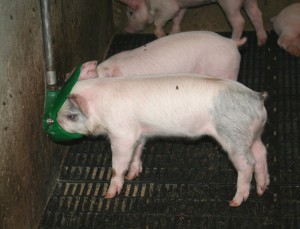Introduction
Feeding and management of the weaned pig has a significant impact on not only nursery performance but also can affect subsequent performance in the grow-finish phase. Though costs incurred in the nursery phase represent approximately 15% of the total cost to produce a pig there is a lot variation between farms and in many cases opportunity to decrease this. Tremendous strides have been made in improving the performance of early weaned pigs in the last decade. These improvements are due to rapid development and implementation of advanced technologies in the areas of improved feeding programs, increased weaning age and weight, and the development of innovative management systems. This article will cover some of the practical reasons for missed closeouts.
1. Age and weight of the pig at weaning
2. Barn cleaning and setup
It is imperative that all nursery rooms are properly cleaned and disinfected with an appropriate disinfectant and given adequate time to dry prior to arrival of new pigs to the barn. The primary objective when washing barns is to get everything clean. This involves removing all organic matter, washing thoroughly to remove all manure and feed. Disinfecting is important but does not do any good unless the barn is clean. Pre-soaking the barn before trying to wash will speed up the washing process. It is important that everything is washed including ceilings, water cups and lines, walls, floors, feeders, mats /trays (top and bottom) and bowls. The room should be allowed to dry before disinfecting. The act of drying itself will kill many organisms by desiccation and a dry room is easier to inspect to see if everything is clean. A disinfectant rotation program should be used in consultation with your vet.
 Room preparation and setup prior to pig arrival is the final step. Set feeders in place and tie down feed spouts. Replace all rods that may have been removed for cleaning. Damaged feeders and other equipment should be fixed and other required maintenance carried out as needed. Water cups or nipple drinkers should be checked to ensure clear water supply, adequate flow rate, and they are adjusted to the correct height for the incoming pigs. Rooms should be pre-warmed before the pigs arrive, with controllers and inlets set for new pigs.
Room preparation and setup prior to pig arrival is the final step. Set feeders in place and tie down feed spouts. Replace all rods that may have been removed for cleaning. Damaged feeders and other equipment should be fixed and other required maintenance carried out as needed. Water cups or nipple drinkers should be checked to ensure clear water supply, adequate flow rate, and they are adjusted to the correct height for the incoming pigs. Rooms should be pre-warmed before the pigs arrive, with controllers and inlets set for new pigs.
3. Piglet care and management during the first 48 hours
The first challenge of the newly weaned pig is finding feed and water. Right after weaning weaned pigs exhibit feeding behavior similar to nursing the sow where all go to the feeder at the same time. Many producers use feeding mats or trays for the first few days post-weaning on which feed is placed multiple times per day in addition to feed being available in the feeder. It is important that feed mats or trays have  a lip or rim on them to prevent piglets from pushing the feed off into the pit and limited to use for 1-3 days as feed wastage tends to be higher compared with when pigs eat from a conventional dry feeder. Teaching feeding behaviour to pigs that do not start up on feed is critical during the first 24-48 hours. This involves identifying the pigs not eating, taking a small handful of feed, wetting it with water and placing in the pig’s mouth. The moist feed will stick to the pigs tongue and it will swallow it. Gently place the pig at the feeder so the pig associates food in its mouth with the feed in the feeder. Water intake is critical to the newly weaned pig. Nipple drinkers or cups should be easily accessed during the first few days after weaning. Water pressure should be < 20 psi. Water should be allowed to drip during the first 12 hours so pigs can find water more easily. Monitor pig lying behaviour to ensure pigs are warm and comfortable. If pigs are lying on their side through the pen this is a good indication that room temperature is correct for the age and weight of pig, however, if pigs are huddled on top of each other this indicates they are too cold.
a lip or rim on them to prevent piglets from pushing the feed off into the pit and limited to use for 1-3 days as feed wastage tends to be higher compared with when pigs eat from a conventional dry feeder. Teaching feeding behaviour to pigs that do not start up on feed is critical during the first 24-48 hours. This involves identifying the pigs not eating, taking a small handful of feed, wetting it with water and placing in the pig’s mouth. The moist feed will stick to the pigs tongue and it will swallow it. Gently place the pig at the feeder so the pig associates food in its mouth with the feed in the feeder. Water intake is critical to the newly weaned pig. Nipple drinkers or cups should be easily accessed during the first few days after weaning. Water pressure should be < 20 psi. Water should be allowed to drip during the first 12 hours so pigs can find water more easily. Monitor pig lying behaviour to ensure pigs are warm and comfortable. If pigs are lying on their side through the pen this is a good indication that room temperature is correct for the age and weight of pig, however, if pigs are huddled on top of each other this indicates they are too cold.
4. Diets and feeding program
Our objective when designing diets is to maximize feed intake and performance while minimizing feed cost from weaning to 25 kg. In formulating diets for weaned pigs a number of important principles to adhere to:
1) For a cost effective feeding program we must adjust pigs to the simplest and relatively lowest cost diets (grain and soybean meal) as quickly as possible after weaning.
2) A newly weaned pig is in a very energy dependent stage of growth and maximizing feed intake is very important.
3) Early diets need to contain ingredients that are highly digestible (fishmeal, whey powder, etc) due to the limited digestive enzyme capacity of newly weaned pig.
Regardless of the phase feeding strategy a producer decides to use, development of a proper feed budget will help keep nursery feed cost competitive. The budget should be adapted to the age and weight of pig for each particular nursery. Strict adherence to the feed budget is critical to prevent feeding the expensive diets after the desired weight range is reached. A common mistake in the field is overfeeding of the more expensive diets, which results in high feed cost in the nursery. Feed budget monitoring target vs actual usage per pig is very important for all barns to ensure budgets are being correctly followed. A suggested feeding program based on pig age at weaning is outlined in Table 2.
|
Table 2: Feeding program based on pig age at weaning, kg/pig. |
|||||||
|
|
|
|
|
|
|
||
|
|
|
Weaning age, days |
|
||||
|
Diet |
Cost, $/T |
15-17 |
18-21 |
22-24 |
25+ |
% |
|
|
|
|
|
|
|
|
|
|
|
SEW |
1,000 |
0.5 |
0.25 |
0 |
0 |
0-2 |
|
|
Starter 1 |
750 |
2.5 |
2.5 |
2.0 |
0 |
0-8 |
|
|
Starter 2 |
450 |
7.0 |
7.0 |
7.0 |
7.0 |
22.0 |
|
|
Starter 3 |
260 |
15.0 |
15.0 |
15.0 |
15.0 |
47.0 |
|
|
Pre-grower |
230 |
7.0 |
7.0 |
7.0 |
7.0 |
22.0 |
|
|
|
|
|
|
|
|
|
|
5. Ingredient quality and diet manufacturing
In selecting specialty ingredient sources for early nursery diets it is important to remember that all sources are not equal and this is very much the case when we consider whey powder or permeate and fishmeal. There can be very significant differences in quality of different sources of the former products. We normally specify that only an edible grade whey powder or permeate be used in early-weaned pig diets. The main concern with some of these sources is the type of drying process (drum vs spray dried) used and in some cases blending of different grades of products occurs. The newly weaned pig is sensitive to differences in ingredient quality and will respond (feed intake and growth rate) accordingly if quality is sub-optimal.
Another important and integral part in the manufacture of high quality starter diets is avoiding cross-contamination of ingredients and feed in the feed mill. Weaned pigs are very sensitive to non-desirable ingredients such as canola meal, screenings, urea, etc and will reduce feed intake even with very small quantities of these ingredients getting into starter diets. Some potential areas of concern for cross-contamination in commercial feed mills are receiving pits, ingredient weigh scales, and out-loading bins.
6. Diet composition and cost transparency
Like all other phases of production it is important that producers have full transparency in terms of diet composition, all ingredient costs, and toll manufacturing rate for all nursery diets. In my experience it has not been uncommon for us to increase nursery margin over feed cost by $1-3 per pig for some new clients by in part giving full transparency on diet composition, ingredient costs, and setting a toll rate and monitoring ingredient costs monthly with a feed mill for nursery diets.
7. Feeder type and management
 Feeder type and management can have a very significant impact on pig performance and feed cost in the nursery. A trial conducted at Agricultural Institute of Northern Ireland by O’Connell et al. (1999) comparing different nursery feeders found some interesting differences. They compared 4 different feeder types (Dry multi-space, Wet and dry multi-space, Maximat (Echberg), Lean Machine (similar to Domino), and Verba) for the nursery. They found a trend for improved growth rate for the dry and wet and dry multi-space feeders, due to the higher level of feed intake compared with the other feeders. Feed conversion was poorer with the wet and dry multi-space than the dry multi-space feeders, which resulted in a $1.16/pig higher feed cost between 4 and 11 weeks of age. They also noted that the wet and dry multi-space feeders were more difficult to manage. Based on the research and commercial experience economic and biological performance is optimized in the nursery with a multi-space dry feeder.
Feeder type and management can have a very significant impact on pig performance and feed cost in the nursery. A trial conducted at Agricultural Institute of Northern Ireland by O’Connell et al. (1999) comparing different nursery feeders found some interesting differences. They compared 4 different feeder types (Dry multi-space, Wet and dry multi-space, Maximat (Echberg), Lean Machine (similar to Domino), and Verba) for the nursery. They found a trend for improved growth rate for the dry and wet and dry multi-space feeders, due to the higher level of feed intake compared with the other feeders. Feed conversion was poorer with the wet and dry multi-space than the dry multi-space feeders, which resulted in a $1.16/pig higher feed cost between 4 and 11 weeks of age. They also noted that the wet and dry multi-space feeders were more difficult to manage. Based on the research and commercial experience economic and biological performance is optimized in the nursery with a multi-space dry feeder.
|
Table 3: Performance by feeder type during the nursery (4 to 11 weeks of age) |
|||||||
|
Parameter |
|
Dry multi- space |
Wet & dry multi space |
Maximat |
Lean Machine |
Verba |
P |
|
|
|
|
|
|
|
|
|
|
Feed intake, g/d |
|
897b |
951c |
863ab |
839a |
824a |
*** |
|
ADG, g/d |
|
598 |
605 |
577 |
572 |
575 |
NS |
|
Feed:gain |
|
1.50b |
1.58c |
1.49b |
1.47ab |
1.42a |
*** |
|
|
|
|
|
|
|
|
|
|
|
|
|
|
|
|
|
|
Feeder management can and does have a very significant impact on feed efficiency and cost in the nursery. Feeder type and diet form will also dictate how frequently and how aggressively feeders need be adjusted. For a dry multi-space feeder we aim to see no more than 20% of the pan covered with feed. Feeders need to be checked daily and adjusted as required.
8. Standing Operating Procedures and Training
Having standing operating procedures (SOP) clearly detailed and in place for pig husbandry, barn management, pig health care, and feed management is important to achieve economic and biological performance targets. In addition ensuring all barn staff clearly understands the SOPs and what is required from them daily is an integral part of this. Training for new staff members, which includes reviewing and ensuring they understand SOPs is an equally key part in helping to ensure targets are achieved. A review process needs to be put in place whereby daily procedures are reviewed quarterly to ensure SOPs are being implemented as set out.
9. Performance analysis
Reviewing performance at the end of each batch for AIAO or month (for previous 3 or 6 months) for continuous flow barns is important to know if biological and economic targets are being achieved. Performance data should be adjusted for explainable sources of variation such as exit weight. Failure to maintain accurate performance data for the nursery will leave it impossible to determine if targets are being achieved and where efforts need to be focused to make up short falls.
Photo captions:
Nursery heater – Prior to placing pigs in the nursery, the heating system should be checked and cleaned
Nursery_pigs_feeding-2 – Offering feed on trays for the first few days after weaning increases feed intake
Water bowl-1 – Fixing drinkers at the correct height for newly weaned pigs is important to ensure good water intake









